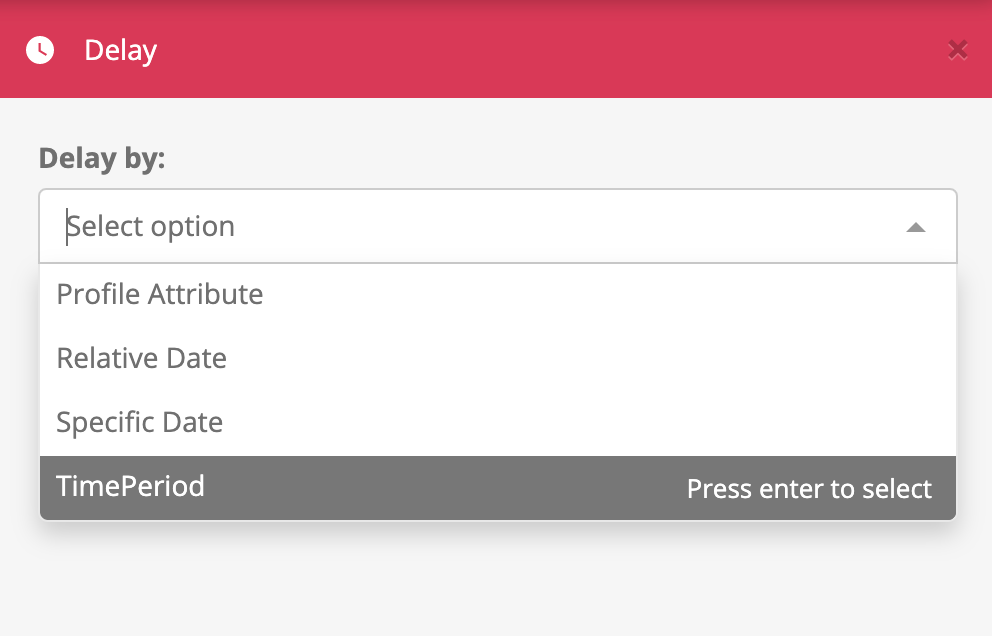Multi stage journey: delay action
Delay actions cause user profiles to be delayed from moving through the workflow.

To set the delay for a user profile in the workflow, click on the Delay action.
This opens the delay toolbox which shows the options for delaying user profiles.

Changes to a delayUsers are evaluated for delay at the point of reaching the delay action. Any users already in the are not affected by changes applied to the delay after the entry.
There are different options available:
Time period
Sets a specific length of time that the user profile will be delayed at this action for.
Specific date
Sets a specific date (and optionally, time) that all user profiles will be delayed at this action until.
If the include time box is not checked, the time the user profile arrived at the action will be used.
Specific time
Sets a specific time that all user profiles will be delayed at this action until. It could be at specific time on the same day or at the specific time following day, depending on the "Following day" checkbox state.
If at the point of execution the specified time has already been reached - the user will proceed to the next step immediately.

Profile attribute
Delay the user profile until the current date/time matches the date/time stored in a date profile attribute.
If no time is supplied, then the time that the user profile arrived at the action will be used.
Date attribute timezoneDate attributes are in the UTC timezone, so if your project is in a different timezone, you can offset the timezone in the attribute value. For instance, if your project is in New York time, you can offset the attribute value by +5 hours
2023-12-13 11:36:00 +05:00.
Relative date
Delay the user profile until a date/time relative to the date/time stored in a profile attribute or an event property. Select Relative date to use this feature.
When the date/time has passed
If a user profile arrives at a delay and the date/time has already passed, then they will not be delayed and will pass straight through.
When a workflow is restarted, if the date/time that the user profile should have moved on has passed, then they will be automatically moved on immediately.
Delay relative to an attribute
To use this option select Profile Attribute and select the attribute that you want to use from the dropdown menu.
This is a similar option to the profile attribute delay. The profile attribute delay will delay users until the exact/date time stored in an attribute, whereas in this case, you delay users a number of days, hours or minutes before or after the date/time stored in the attribute.
Delay relative to an event property
This option uses a date/time stored in the JSON payload passed with an event. It can be used in event-triggered workflows (using the data passed with the event that triggers the campaign).
To use this option, select Event property and type the name of the property where the date/time is stored.

In this example, there is a delay of 1 hour after the date/time indicated in the property visit_date.
Changing valuesEvent properties are linked to the specific event that triggered the workflow journey. This means that if a user is on the same journey multiple times, the value in the event property may be different each time.
Allowed resume window
There may be times when it isn't appropriate to release a user from the delay action at the same time of day as they arrived. Usually, if the following action is to send a message and you do not wish to disturb the user in the early hours.
In this situation a finer degree of control can be achieved by using the allowed resume window option.

In this example, the message following a delay can only be sent between 8am and 12pm.
Setting the start and end times here mean that a user will only be released from a delay at the time they are scheduled to do so if that time (based on the timezone set against their profile) also falls within the allowed resume window. If the user doesn't have a timezone set, then this will default to the timezone set against the project.
If the time is outside this window then the user is simply held at the delay until the next window opens.
ExampleUser signs up to a website at 11pm and makes a purchase.
An order confirmation follows immediately after and the user then continues to a delay of 1 day before a promotion for new users is due to be sent.
Knowing that their particular user base tend to engage more with these kind of offers in the mornings, the marketer chooses to add an allowed resume window of 8am - Midday.
After the 1 day delay for that user, the time is 11pm so the user is held at that delay until the following morning at 8am before they continue on and arrive at the message action.
Updated 17 days ago